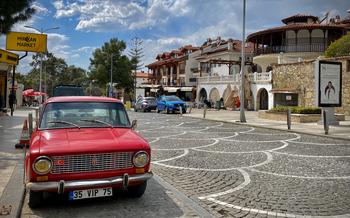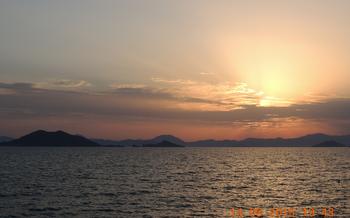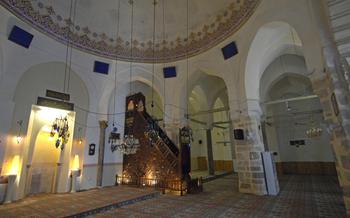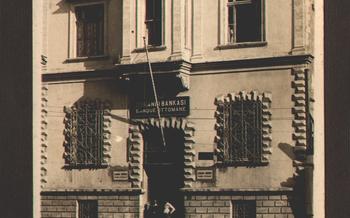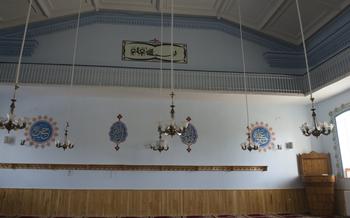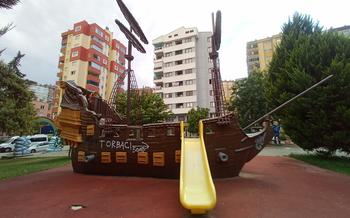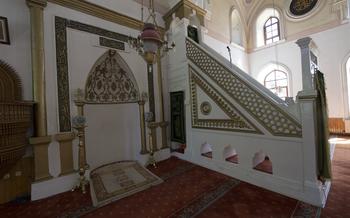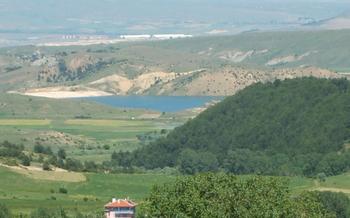
Kesik Minaret Mosque
- The Antiquity of the City and the Mosque's History
- Location and How to Get There
- Architectural Features
- The Minaret and Its Significance
- The Mosque's Interior
- Visiting the Mosque
- The Mosque's Surroundings
- The Mosque's Role in the Community
- Historical Importance
- Religious Significance
- Cultural Importance
- The View from the Minaret
- The Call to Prayer
- The Mosque's Legacy
- Insider Tip:
The Antiquity of the City and the Mosque's History
Fethiye, a picturesque city on Turkey's Turquoise Coast, boasts a rich history dating back to ancient times. Once known as Telmessos, the city served as a significant port town during the Lycian era, around the 5th century BC. Its strategic location attracted various civilizations, including the Persians, Greeks, and Romans, each leaving their mark on the city's cultural tapestry.
Amidst Fethiye's historical treasures stands the Kesik Minaret Mosque, a testament to the city's Islamic heritage. Built in the 13th century during the Anatolian beyliks period, the mosque holds a prominent place in Fethiye's skyline, symbolizing the city's deep-rooted Islamic traditions. The mosque's architectural features and historical significance make it a must-visit attraction for anyone interested in exploring Fethiye's cultural heritage.
Location and How to Get There
The Kesik Minaret Mosque is strategically located in the heart of Fethiye, making it easily accessible for visitors. Situated on Cumhuriyet Mahallesi, Fethiye Merkez, the mosque stands as a prominent landmark amidst the city's vibrant streets.
Reaching the Mosque:
-
On Foot: For those who prefer a leisurely stroll, the mosque is conveniently within walking distance from the city center. Simply follow the charming streets, admiring the local shops and cafes, until you reach the mosque's impressive façade.
-
By Public Transportation: Fethiye's efficient public transportation system makes it easy to reach the mosque. Several bus routes stop within a short walk of the mosque, providing a convenient and affordable option.
-
By Car: For those traveling by car, there are limited parking options available in the vicinity of the mosque. It is recommended to arrive early to secure a parking spot or consider exploring the city on foot or by public transportation.
Architectural Features
The Kesik Minaret Mosque stands as a testament to the fusion of Islamic and Seljuk architectural influences. Its most striking feature is its minaret, which rises elegantly from the mosque's corner, showcasing an octagonal shape that is unique among minarets in the region. The minaret's intricate brickwork and decorative elements, such as muqarnas (honeycomb-like vaulting), add to its visual appeal.
The mosque's prayer hall, though modest in size, exudes a sense of serenity and devotion. The mihrab, or prayer niche, is adorned with intricate carvings and calligraphy, indicating the direction of Mecca. The minbar, or pulpit, is a testament to the mosque's historical significance, featuring intricate woodwork and serving as a platform for delivering sermons and religious teachings.
The mosque's exterior walls are adorned with decorative stonework and Quranic inscriptions, reflecting the importance of Islamic calligraphy in Islamic architecture. These inscriptions, often in Arabic script, serve as a reminder of the mosque's religious significance and its role as a center of Islamic learning and worship.
The Minaret and Its Significance
The mosque's most striking feature is its minaret, which gives it its name, Kesik Minaret (Broken Minaret). The minaret stands tall and distinct, embodying the mosque's historical significance. Constructed in the 13th century, the minaret has withstood the test of time, becoming an iconic symbol of Fethiye.
The minaret's unique octagonal shape sets it apart from other minarets in the region. This distinctive design adds to its charm and makes it a recognizable landmark. The minaret's height allows for a breathtaking view of the city and the surrounding area, offering visitors a panoramic perspective of Fethiye's beauty.
Despite its resilience, the minaret has not escaped the ravages of time. Its upper section, once reaching for the sky, has been broken off, leaving a jagged stump. This damage, while unfortunate, has only added to the minaret's allure, giving it a sense of mystery and resilience.
The minaret's history is closely intertwined with the mosque's journey. It has witnessed the rise and fall of empires, the ebb and flow of history, and the changing face of Fethiye. Its broken form stands as a testament to the passage of time and the enduring spirit of the mosque.
The Mosque's Interior
The interior of the Kesik Minaret Mosque is a testament to the mosque's rich history and architectural significance. The prayer hall, the central space of the mosque, is a large, open area defined by its elegant arches and serene ambiance. The walls are adorned with intricate calligraphy and tilework, adding a touch of color and artistry to the space.
The mihrab, or prayer niche, is the focal point of the prayer hall. This semi-circular niche indicates the qibla, the direction of Mecca, towards which Muslims face during prayer. The mihrab of the Kesik Minaret Mosque is adorned with beautiful tilework and intricate carvings, highlighting its importance as a sacred space.
Next to the mihrab is the minbar, or pulpit, from which the imam delivers sermons and leads prayers. The minbar of the Kesik Minaret Mosque is a fine example of woodworking, featuring intricate carvings and inlaid mother-of-pearl.
The mosque's interior also features a number of other decorative elements, such as stained glass windows, chandeliers, and carpets. These elements contribute to the mosque's overall atmosphere of tranquility and spirituality, creating a space conducive to prayer and contemplation.
Visiting the Mosque
The Kesik Minaret Mosque welcomes visitors from all backgrounds to explore its historical and spiritual significance. The mosque observes specific visiting hours, typically from 9 am to 5 pm daily, to ensure that worshippers and visitors can enjoy a peaceful and respectful environment. When visiting the mosque, it is essential to dress modestly and respectfully, covering your shoulders and knees. Women may also choose to cover their heads as a sign of respect for Islamic customs.
Upon entering the mosque, visitors are greeted by a serene and tranquil atmosphere. It is customary to remove your shoes before entering the prayer hall, following the Islamic tradition of cleanliness and purity. Inside the mosque, visitors can admire the intricate details of the architecture, including the beautifully crafted mihrab (prayer niche) and minbar (pulpit). The mihrab, facing towards Mecca, is a focal point of the mosque and symbolizes the direction of prayer for Muslims.
To capture stunning photographs of the mosque's interior and exterior, it is recommended to visit during the golden hours of sunrise or sunset. The warm, diffused light during these times enhances the mosque's architectural features and creates a picturesque backdrop for capturing memorable shots.
The Mosque's Surroundings
The Kesik Minaret Mosque is nestled in the heart of Fethiye's vibrant neighborhood, where the city's rich history and culture come alive. Just steps away from the mosque, visitors can immerse themselves in the lively atmosphere of the Fethiye Bazaar, a bustling marketplace where vendors display an array of traditional Turkish handicrafts, souvenirs, and fresh produce.
A short stroll from the mosque leads to the Fethiye Museum, which houses a fascinating collection of artifacts that narrate the city's captivating history. Discover ancient relics, intricate pottery, and insightful exhibits that shed light on Fethiye's role as a crucial crossroads of civilizations.
Venturing further into the Old Town, visitors are greeted by a labyrinth of narrow cobblestone streets lined with charming shops, cozy cafes, and traditional Turkish restaurants. Here, one can savor the flavors of local cuisine, indulge in sweet delights at traditional confectioneries, or simply bask in the ambiance of this historic quarter.
Whether it's exploring the vibrant Fethiye Bazaar, delving into the past at the Fethiye Museum, or getting lost in the enchanting alleys of the Old Town, the surroundings of the Kesik Minaret Mosque offer a multitude of experiences that complement a visit to this sacred landmark.
The Mosque's Role in the Community
The Kesik Minaret Mosque is not just a religious landmark but also a vibrant center for the Muslim community in Fethiye. It serves as a gathering place for worshippers, providing a sense of unity and belonging. The mosque hosts daily prayers, including the five obligatory prayers and the special Friday prayer. During the holy month of Ramadan, the mosque becomes particularly lively, with special prayers, recitations, and community gatherings.
Beyond its religious function, the mosque also plays a significant role in the cultural and social life of the community. It hosts various events throughout the year, such as religious festivals, educational seminars, and charitable activities. These events provide opportunities for Muslims to come together, strengthen their bonds, and contribute to the overall well-being of the community.
The mosque's imam and staff are dedicated to fostering a welcoming and inclusive environment for all visitors. They are always ready to answer questions, provide guidance, and help visitors understand the significance and practices of Islam. The mosque's community outreach initiatives, such as interfaith dialogues and charity work, further contribute to its role as a bridge between different cultures and religions.
Historical Importance
The Kesik Minaret Mosque holds immense historical significance as a testament to the development of Islamic architecture and culture. Constructed during the 13th century, the mosque stands as a remarkable example of Seljuk architecture, blending Islamic design elements with regional influences. Its unique minaret, with its octagonal shape and intricate carvings, further enhances the mosque's historical value. Recognized as a protected monument, the Kesik Minaret Mosque serves as a tangible link to Fethiye's rich past, offering visitors a glimpse into the city's Islamic heritage and architectural evolution.
Religious Significance
The Kesik Minaret Mosque holds immense religious significance for Muslims as a sacred place of worship and a symbol of their faith. It serves as a central hub for the Muslim community in Fethiye, providing a spiritual sanctuary for daily prayers and religious gatherings. The mosque's design and architecture are intricately intertwined with Islamic principles, reflecting the deep-rooted religious beliefs and traditions of the community.
The mosque's main prayer hall, with its serene atmosphere and ornate decorations, invites worshippers to engage in contemplation, prayer, and connection with the divine. The mihrab, or prayer niche, meticulously crafted to face the direction of Mecca, serves as a focal point for the congregation during prayers. The minbar, or pulpit, where the imam delivers sermons and religious teachings, adds to the mosque's spiritual ambiance.
Throughout the year, the mosque hosts various religious events and celebrations, bringing together the Muslim community to commemorate important Islamic holidays and traditions. Ramadan, the holy month of fasting, is a particularly significant time, with special prayers and gatherings held at the mosque. The mosque's role in fostering a sense of community and religious belonging is a testament to its enduring importance as a spiritual center for Muslims in Fethiye.
Cultural Importance
The Kesik Minaret Mosque stands as a testament to the rich Islamic heritage of Fethiye. Its architectural splendor and historical significance make it a symbol of the city's cultural identity. The mosque has played a pivotal role in preserving and promoting Turkish Islamic heritage, showcasing the fusion of Islamic and Seljuk architectural styles.
As a cultural symbol, the mosque attracts numerous visitors who come to admire its exquisite craftsmanship and learn about its historical significance. It serves as a bridge between the past and the present, connecting people with the city's Islamic roots. The mosque's presence in the heart of Fethiye reminds visitors of the deep-rooted Islamic traditions that have shaped the city's cultural landscape.
Moreover, the Kesik Minaret Mosque serves as a venue for various cultural events and gatherings. These events celebrate Turkish Islamic culture through traditional music, dance, and art exhibitions. Visitors can immerse themselves in the vibrant cultural atmosphere of Fethiye and gain a deeper understanding of the city's Islamic heritage.
The mosque's cultural significance extends beyond its physical structure. It embodies the spirit of tolerance and understanding that has characterized Fethiye throughout its history. The mosque welcomes visitors from all backgrounds, fostering a sense of community and respect for different cultures. It stands as a symbol of the city's commitment to preserving its Islamic heritage while embracing diversity and promoting cultural harmony.
The View from the Minaret
Ascending the spiral staircase of the Kesik Minaret is an experience in itself, offering a unique perspective of the mosque's intricate architecture and the surrounding cityscape. Once you reach the top, you'll be greeted by a breathtaking panoramic view of Fethiye and its stunning surroundings. The azure waters of the Mediterranean Sea stretch out before you, framed by the lush green mountains that cradle the city.
The view from the minaret allows you to appreciate the city's layout and its relationship to the natural landscape. You can spot the bustling harbor, with its colorful fishing boats and sleek yachts, and the Old Town, with its charming cobbled streets and whitewashed buildings. The nearby Fethiye Museum and the ancient rock tombs are also visible from this vantage point.
The panoramic view from the minaret is not just a visual treat but also a reminder of the mosque's historical significance. As you gaze out over the city, you can imagine the muezzin's call to prayer echoing through the streets centuries ago, summoning the faithful to gather for worship within the mosque's sacred walls. The view from the minaret is a powerful reminder of the role that the Kesik Minaret Mosque has played in shaping the identity and history of Fethiye.
The Call to Prayer
The call to prayer, known as the adhan, is an integral part of the Muslim faith and a captivating experience for visitors to the Kesik Minaret Mosque. Five times a day, the melodious chanting of the muezzin echoes from the mosque's minaret, summoning the faithful to prayer. This sacred call reverberates through the air, inviting Muslims to come together and worship.
The adhan consists of several phrases, each with its significance. It begins with the declaration of God's greatness (Allahu Akbar), followed by the testimony of faith (Ashhadu an la ilaha illa Allah, wa ashhadu anna Muhammadan rasul Allah). These phrases emphasize the oneness of God and the prophethood of Muhammad. The call concludes with an invitation to prayer (Hayya 'ala al-salat, hayya 'ala al-falah) and a reminder of the hereafter (La ilaha illa Allah).
Visitors to the mosque are welcome to listen to the adhan and observe the Muslim community as they gather for prayer. This experience offers a glimpse into the religious and cultural traditions of Fethiye and provides a deeper understanding of the mosque's significance as a place of worship. If you happen to be in the vicinity during the call to prayer, take a moment to pause and appreciate the beauty and solemnity of this sacred ritual.
The Mosque's Legacy
The Kesik Minaret Mosque stands as a testament to the enduring legacy of Islamic architecture and culture in Fethiye. Its unique blend of Seljuk and Ottoman architectural styles has inspired generations of visitors and remains a source of pride for the local Muslim community. The mosque's ability to withstand the test of time, despite centuries of natural disasters and political upheaval, speaks to its exceptional craftsmanship and resilience.
Today, the Kesik Minaret Mosque continues to attract visitors from around the world who come to admire its beauty and learn about its rich history. It serves as a reminder of the importance of preserving cultural heritage and promoting religious tolerance and understanding. The mosque's legacy extends beyond its physical structure, as it continues to inspire and influence contemporary Islamic architecture and design.
Insider Tip:
For a unique experience, visit the mosque during the evening when it is beautifully illuminated, casting a magical glow on the surrounding area. Take advantage of the opportunity to capture stunning photographs of the mosque against the backdrop of the night sky. To make the most of your visit, consider exploring the nearby Old Town, a vibrant neighborhood filled with charming cafes, traditional shops, and historical landmarks. Don't miss the opportunity to savor delicious Turkish cuisine at one of the local restaurants, offering a culinary journey that complements your cultural exploration.
